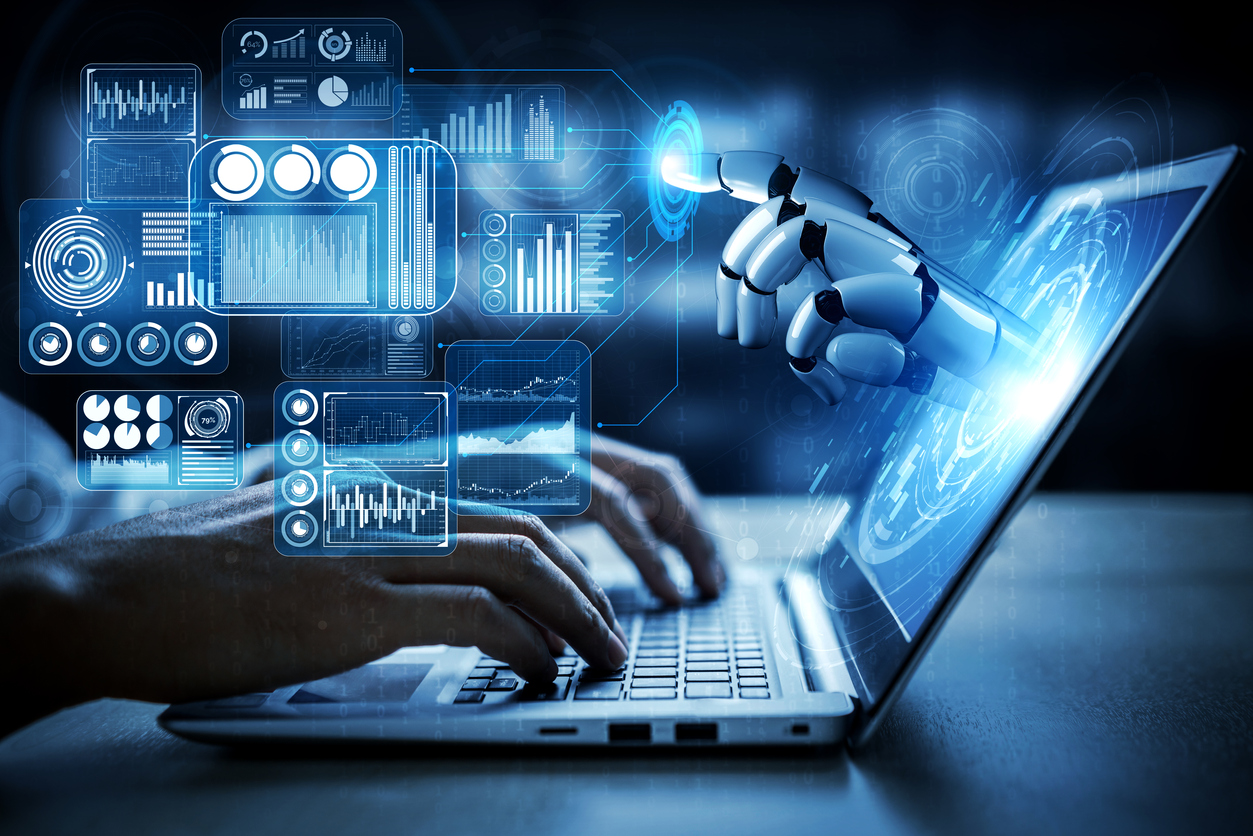January 5, 2024
 by Chloe Schneider / January 5, 2024
by Chloe Schneider / January 5, 2024

When researching a marketing trends piece, a few key themes usually emerge.
This year was different. Every emerging marketing trend is connected to a single key theme: the rapid advancements in artificial intelligence (AI).
AI is undeniably driving marketing automation right now, and 2024 is set to be a very exciting time.
2023 was undoubtedly the year of generative AI, thanks in large part to the widespread adoption of ChatGPT and the excitement that followed.
In a survey published in August, McKinsey and Company shared that one-third of respondents were using gen AI regularly in at least one business function at their organization, and 40% confirmed they would increase their overall investment because of the advances in gen AI.
Considering that most gen AI tools debuted less than a year ago and many businesses have to get through layers of corporate red tape to adopt new technologies and tools, these stats are nothing short of remarkable.
Such a sharp lift in interest and adoption has led to three major shifts in marketing automation:
Marketers do not like to be left behind.
The more the industry buzzed around AI, the more urgent the need to build strategies around AI adoption. Marketing automation presented itself as the natural place to start.
Any doubt surrounding AI becoming a part of our daily lives was essentially eradicated when the world at large tried out ChatGPT.
This meant that SaaS companies no longer had to argue for investing time, money, and resources into AI – it went from being a nice-to-have to a must-have overnight.
AI is a little like its very own growth loop.
With increased use comes increased intelligence, both on the AI’s part and in the marketer’s understanding of AI. This leads to the discovery of new use cases and over time, AI and automation become an increasingly prevalent part of the marketer’s day-to-day life.
The shifts we saw in 2023 have set the stage for 2024, when AI will really start to feel like a colleague, one who marketers can successfully work with to do things they never dreamed possible.
Not so long ago, marketers talked much about live chat vs. chatbots.
Live chat was generally preferred by businesses that wanted to guarantee accurate information preferred live chat, but 24/7 service requires a large, global support team.
Chatbots, on the other hand, could answer simple questions accurately around the clock, but they lacked the human touch brands needed to build relationships with leads and customers, and they fell short with complicated or unique questions.
Today, a new option has presented itself: AI-powered live chat.
It’s essentially the best of both worlds – AI can help human support agents find the necessary information. It can answer simple questions with accuracy or escalate conversations to the right people with full context.
This welcomed evolution has led to a few major improvements and new use cases in chatbots.
Counterintuitive as it may seem, the increased adoption of AI in marketing could make a company’s interactions with customers more human.
Firstly, there’s a practical matter.
When a chatbot is answering simple queries or directing customers to self-help documentation, human support agents can spend more time responding to complicated inquiries and building relationships.
Plus, when live chat messenger platforms and inboxes have AI support, information can be automatically surfaced, giving human agents time to focus on improving the accuracy of information and personalizing the experience for their customers.
At the same time, the machines are becoming more human. Natural language processing (NLP) models use neural networks to train themselves on information and the conversations they have with people. Advanced NLP chatbots can discern meaning from language to respond more naturally, and over time, they learn more about human speech patterns, colloquialisms, and tone in order to humanize their voice.
Although true emotional intelligence is still a ways off, sophisticated chatbots can detect sentiments in conversation and react accordingly.
In addition to making conversations feel more human, sentiment analysis can fuel greater reporting and insights.
Getting a better understanding of how your customers feel about their interactions with your brand – and how that sentiment changes when the customer interacts with a human vs. a robot – can help you improve relationships with customers.
AI’s ability to chew through piles of data is one of its greatest strengths, and live chat generates heaps of individual data points around sentiment analysis. You can use this to assess sentiment and drill down to identify why customers feel a certain way. Use the analysis to develop a data-driven strategy around customer happiness – and act on it with the help of AI.
Live chat became an important marketing channel in part because consumers who use messaging services like Slack, WhatsApp, and Messenger got comfortable with this style of communication. They wanted the same convenience when they chatted with businesses.
Voice assistants are heading in the same direction. 24% of US adults own a smart speaker, and the number of digital voice assistants in use worldwide is set to grow to 8.4 billion in 2024. We were only at 4.2 billion in 2020!
Right now, voice search is the area with the most growth, especially for local businesses that want to be the answer when a potential customer asks for the nearest gas station or grocery store.
In 2024, however, businesses could start to build custom voice assistants so that SaaS application users, for example, can find help while they work and have the voice assistant walk them through instructions one at a time. Anyone who has asked their Google Assistant to share a recipe with them knows just how useful this is if you’re focusing on a task.
And, like chatbots before them, voice assistants will learn to sound more human since they have more interactions with real people. They’ll learn to pause, emphasize, and raise or lower their voice at the right time. They’ll even use different accents and turns of phrase.
Support teams using an AI-powered live chat and businesses with Slack bots are already getting company information from a chatbot. In 2024, as more companies adopt and use AI-powered live chat tools for their marketing, sales, and customer support purposes, businesses will find ways to use them for internal education purposes.
For example, imagine an onboarding experience led by a chatbot. A new user starts. They can interact with a chatbot that guides them through the onboarding process and elevates questions to the right team members as required.
Part of this will simply be opportunity spotting for businesses – how can they refine something they do repeatedly? And part of it will be the desire to make the most of the tools they pay to use.
As a bonus, a chatbot trained to internally answer questions about products, services, and your brand will be better suited to answer questions that come from leads and customers.
Finally, in 2024 customers will grow to expect all businesses to have some kind of chat experience available to them.
Customers who need help are already actively looking for a bot bubble in the bottom right-hand corner of your website or app, but by the time we’re ringing in 2025, they’ll be annoyed if they can’t find it there.
Adopting AI-powered live chat now doesn’t just mean you’ll meet your customer’s future expectations; it means your AI model will have learned more about your brand, products, and services so it can easily talk to your customers with more accuracy, maybe even a human touch.
Perhaps the most transformative application of AI in marketing automation is predictive analytics.
When your data can be used to foretell the future, your AI-powered marketing automation platform will be able to make data-driven decisions on its own without your help. It’s a dream for marketers who want to set up reliable set-and-forget automated journeys.
There are plenty of applications of predictive analytics that we interact with every day, from the weather forecast to behavioral targeting in advertising. But these are still imperfect, especially if you’re trying to make a prediction far into the future.
Given the rapid advancements in technologies, we’re fairly close to a world where predictive analytics could be used to forecast things like inventory requirements, revenue, and staffing needs well into the future and with precision – and all of this could be available to businesses of every size.
The potential is huge. Here are just a few of the use cases that we could see emerging in 2024.
Email subject line performance is one area where AI thrives.
We already get accurate predictions on open rates along with suggestions on higher-performing alternatives. With time, marketers could use their automation platforms to predict metrics that come with higher stakes.
For example, what if you could predict the ROI of a campaign before you set it live? That could become a reality for marketing automation once predictive analytics can comb through the performance of similar campaigns, audiences, and objectives to crunch the numbers and accurately forecast performance.
Lead scoring has improved dramatically thanks to more sophisticated models and algorithms. However, it generally still relies on humans to identify the set of attributes or behaviors that determine lead quality.
If things advance as they are, predictive analytics in marketing automation platforms will be able to identify the quality of a lead based on available data points – without the need for a model. A marketing automation tool underpinned by AI could automate the entire lead scoring process
For example, AI could identify top-performing customers to establish a set of attributes or behaviors that indicate a lead could go on to be a high-worth customer. With this information, AI could automatically qualify leads and route them to the most appropriate sales representative.
Retention and churn prevention have become two of the hottest topics in marketing.
Customer acquisition costs (CAC) are soaring, and the need to maintain a base of loyal, high-value customers has increased.
Like lead quality, right now, marketers can identify a set of behaviors that tend to indicate churn (for example, viewing cancellation terms) and set up marketing automation journeys to ensure support and success teams are notified so they can intervene.
In the future, we could do away with the manual step of behavior identification and let the predictive analytics do its work to crunch the numbers, identify trends and insights, then spot at-risk customers to automatically enter them into sophisticated, personalized retention journeys or escalate them to a team member for human intervention.
Thanks to certain driving apps, we’re all familiar with surge pricing. The model is straightforward – increased demand leads to an increase in pricing. But the potential doesn’t stop there. AI-enabled pricing management tools can predict optimal pricing based on inventory levels, competitor pricing, and customer response to price changes.
In cases where pricing is more complicated, like SaaS and B2B businesses with subscription tiers, we could start to see something similar. Predictive price optimization is a specific field of predictive analytics.
Its users take into account customer behaviors, market trends, competitors’ pricing models, and the state of global financial markets to predict how successful your pricing strategy will be.
Marketing automation has let marketers scale personalization. Without it, we’d be sending millions of manually-written emails every day – a task no modern marketing team can or should have time for.
With AI, personalization at scale takes on a whole new meaning. Omnichannel messages feel truly one-to-one, with every element – from tone to content, recommendations to calls-to-action – changing based on the individual audience member’s attributes and behaviors.
Exciting as this is, marketers will need to grapple with an opposing force. 2024 will be a year of reckoning when it comes to privacy, and every marketer will need to question the data they collect, how they collect it, and how they use it. We’re already seeing this play out with Google’s impending removal of third-party cookies from Chrome.
One upshot of that could be a renewed focus on first- and zero-party data collection that AI-powered marketing automation platforms can use to create actual personalized experiences.
AI can already write emails, subject lines, SMS, and push notifications in your brand voice with personalized elements like merge tags.
In the future, things could get even more personal. We could see a world where marketing automation platforms underpinned by AI can write email and SMS messages for a specific audience segment or even individual.
This would require the AI to comb through data and identify the subject lines, tone, format, and calls-to-action the segment is more likely to respond to and then use that information to write an email.
When this happens, personalization will be less about plugging in pieces of information like first name, industry, and plan details or previous purchases, and more about tone adjustment and composition of the message.
Recommendation engines are built on AI.
They take data about the products people buy or the content they consume and use it to draw conclusions about what people with similar purchasing or viewing habits will like. In a marketing automation tool, a recommendation engine will send suggestions to re-engage lapsed customers or upsell active customers.
With AI backing up marketing automation, these recommendations could become even more personal. The AI could learn what each individual user shows an interest in and what they ignore, and adjust future recommendations accordingly. It’s another use case where advanced predictive analytics comes into play.
Marketing automation platforms take the heavy lifting out of customer lifecycle marketing. Marketers can now build omnichannel campaigns that nudge leads and customers to the next phase of the customer journey. To do this successfully, marketers need to use data to identify what the next best action is at each stage of the customer’s journey.
With predictive analytics, marketing automation platforms could forecast future steps without human intervention and send individual customers the most relevant guidance based on those steps. We could also see technology that sends messages at the most optimal time based on the user’s previous behavior.
Essentially, AI could remove the need for guesswork and manual intervention at every stage of the journey.
The sooner marketing teams adopt automation and AI, the more the AI (and your team!) will learn.
With that experience and knowledge, AI will deliver better outcomes, and marketers will identify new, creative use cases to set them apart from competitors.
Ready to amplify your marketing strategy? Discover the ultimate digital marketing guide for maximizing your business ROI.
Edited by Aisha West
With the average buying journey growing more complex, businesses turn to multi-touch...
 by Jeremy Sacramento
by Jeremy Sacramento
Multi-channel marketing allows you to engage with your audience where they are, all at once.
 by Sagar Joshi
by Sagar Joshi
Tech companies are facing rising costs and decreased funding.
 by Charlie Windschill
by Charlie Windschill
With the average buying journey growing more complex, businesses turn to multi-touch...
 by Jeremy Sacramento
by Jeremy Sacramento
Multi-channel marketing allows you to engage with your audience where they are, all at once.
 by Sagar Joshi
by Sagar Joshi


